2-8复合材料的复合原理及界面
- 格式:pdf
- 大小:1.62 MB
- 文档页数:43
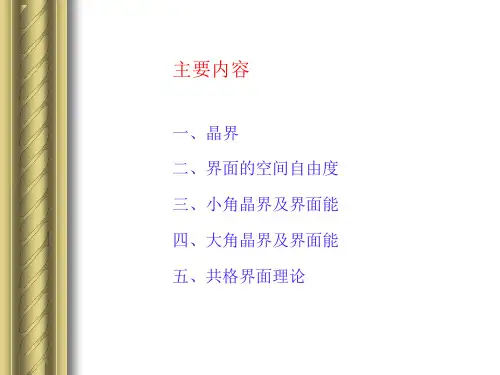

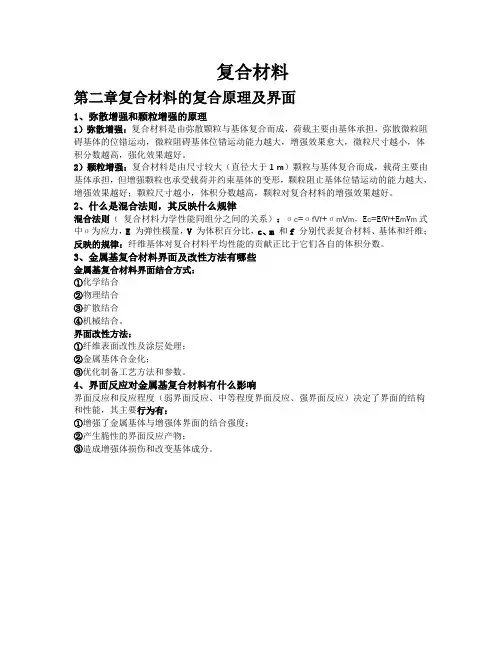
复合材料
第二章复合材料的复合原理及界面
1、弥散增强和颗粒增强的原理
1)弥散增强:复合材料是由弥散颗粒与基体复合而成,荷载主要由基体承担,弥散微粒阻碍基体的位错运动,微粒阻碍基体位错运动能力越大,增强效果愈大,微粒尺寸越小,体积分数越高,强化效果越好。
2)颗粒增强:复合材料是由尺寸较大(直径大于1 m)颗粒与基体复合而成,载荷主要由基体承担,但增强颗粒也承受载荷并约束基体的变形,颗粒阻止基体位错运动的能力越大,增强效果越好;颗粒尺寸越小,体积分数越高,颗粒对复合材料的增强效果越好。
2、什么是混合法则,其反映什么规律
混合法则(复合材料力学性能同组分之间的关系):σc=σf V f+σm V m,E c=E f V f+E m V m式中σ为应力,E为弹性模量,V 为体积百分比,c、m和f 分别代表复合材料、基体和纤维;反映的规律:纤维基体对复合材料平均性能的贡献正比于它们各自的体积分数。
3、金属基复合材料界面及改性方法有哪些
金属基复合材料界面结合方式:
①化学结合
②物理结合
③扩散结合
④机械结合。
界面改性方法:
①纤维表面改性及涂层处理;
②金属基体合金化;
③优化制备工艺方法和参数。
4、界面反应对金属基复合材料有什么影响
界面反应和反应程度(弱界面反应、中等程度界面反应、强界面反应)决定了界面的结构和性能,其主要行为有:
①增强了金属基体与增强体界面的结合强度;
②产生脆性的界面反应产物;
③造成增强体损伤和改变基体成分。



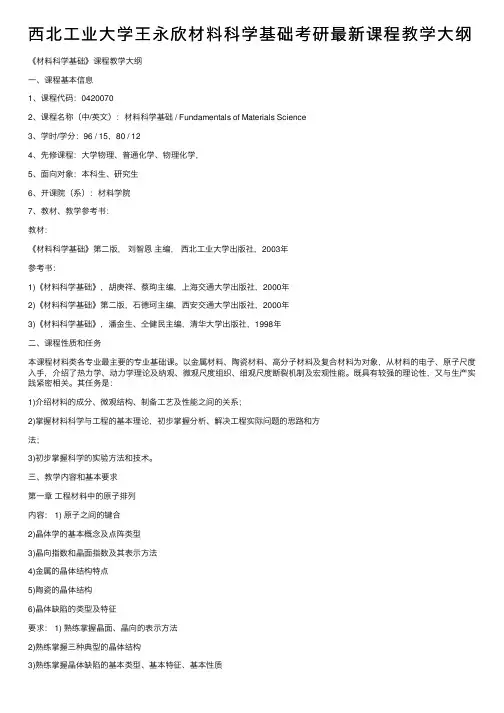
西北⼯业⼤学王永欣材料科学基础考研最新课程教学⼤纲《材料科学基础》课程教学⼤纲⼀、课程基本信息1、课程代码:04200702、课程名称(中/英⽂):材料科学基础 / Fundamentals of Materials Science3、学时/学分:96 / 15,80 / 124、先修课程:⼤学物理、普通化学、物理化学,5、⾯向对象:本科⽣、研究⽣6、开课院(系):材料学院7、教材、教学参考书:教材:《材料科学基础》第⼆版,刘智恩主编,西北⼯业⼤学出版社,2003年参考书:1)《材料科学基础》,胡庚祥、蔡珣主编,上海交通⼤学出版社,2000年2)《材料科学基础》第⼆版,⽯德珂主编,西安交通⼤学出版社,2000年3)《材料科学基础》,潘⾦⽣、仝健民主编,清华⼤学出版社,1998年⼆、课程性质和任务本课程材料类各专业最主要的专业基础课。
以⾦属材料、陶瓷材料、⾼分⼦材料及复合材料为对象,从材料的电⼦、原⼦尺度⼊⼿,介绍了热⼒学、动⼒学理论及纳观、微观尺度组织、细观尺度断裂机制及宏观性能。
既具有较强的理论性,⼜与⽣产实践紧密相关。
其任务是:1)介绍材料的成分、微观结构、制备⼯艺及性能之间的关系;2)掌握材料科学与⼯程的基本理论,初步掌握分析、解决⼯程实际问题的思路和⽅法;3)初步掌握科学的实验⽅法和技术。
三、教学内容和基本要求第⼀章⼯程材料中的原⼦排列内容: 1) 原⼦之间的键合2)晶体学的基本概念及点阵类型3)晶向指数和晶⾯指数及其表⽰⽅法4)⾦属的晶体结构特点5)陶瓷的晶体结构6)晶体缺陷的类型及特征要求: 1) 熟练掌握晶⾯、晶向的表⽰⽅法2)熟练掌握三种典型的晶体结构3)熟练掌握晶体缺陷的基本类型、基本特征、基本性质4)熟练掌握位错的应⼒场和应变能;位错的运动与交互作⽤第⼆章固体中的相结构内容: 1) 固溶体的分类、结构特点及性能2)⾦属间化合物相的分类、特点及性能3)陶瓷晶体相的结构及特点4)玻璃相及其形成5)分⼦相的结构特点要求: 1) 熟练掌握合⾦相的主要类型,形成条件、影响因素和性能特点2)掌握玻璃相的形成条件3)了解分⼦相的结构特点及分⼦晶体第三章凝固与结晶内容: 1) 结晶的基本规律2)结晶的基本条件3)晶核的形成4)晶体的长⼤5)陶瓷、聚合物的凝固6)结晶理论的应⽤要求: 1) 熟练掌握凝固基本规律及过冷度的概念2)熟练掌握形核的基本条件3)熟练掌握晶体长⼤条件、界⾯类型、长⼤机制及固溶体形态4)了解凝固理论解释或说明实际⽣产问题第四章相图内容: 1) 相、相平衡及相图制作2)⼆元匀晶相图3)⼆元共晶相图4)⼆元包晶相图5)其它⼆元要相图6)⼆元相图的分析⽅法7)相图的热⼒学解释8)铸锭(件)的组织与偏析9)三元相图要求: 1) 熟练掌握⼆元匀晶、共晶、包晶相图的特点2)熟练掌握⼆元匀晶、共晶、包晶相图平衡、⾮平衡凝固成分变化规律,能够分析结晶过程及得到的组织,能够熟练运⽤杠杆定律计算相及组织相对含量3)能依据相图判断合⾦的⼯艺性能与机械性能4)掌握铁碳相图,能够分析平衡结晶过程及室温下所得到的相、组织,并计算其相对含量5)初步掌握复杂⼆元相图分析⽅法6)熟练掌握三元合⾦成分表⽰⽅法7)掌握三元合⾦结晶过程中相与组织的转变规律8)能够绘制简单的等温截⾯图和垂直截⾯图第五章材料中的扩散内容: 1) 扩散定律及其应⽤2)扩散的微观机理3)扩散的热⼒学理论4)反应扩散5)⼀些影响扩散的重要因素要求: 1) 掌握扩散第⼀、第⼆定律的表达式及适⽤的条件,各符号的意义和单位2)熟练掌握扩散的微观机制3)熟练掌握扩散系数的意义和影响扩散的因素4)认识⼏种重要的扩散现象5)了解扩散的实际应⽤,如渗碳过程等第六章塑性变形内容: 1) ⾦属的应⼒—应变曲线2)单晶体的塑性变形3)多晶体的塑性变形4)合⾦的塑性变形5)冷变形⾦属的组织与性能6)聚合物的塑性变形7)陶瓷材料的塑性变形要求: 1) 熟练掌握滑移、孪⽣变形的主要特点2)熟练掌握滑移的微观机制3)熟练掌握多晶体塑性变形的过程、特点,以及细晶强化的机理4)熟练掌握合⾦塑性变形的特点,以及固溶强化、复相强化、弥撒强化的机理5)熟练掌握塑性变形对晶体微观组织结构、体系能量、⼒学性能和物理、化学性能的影响第七章回复与再结晶内容: 1) 冷变形⾦属在加热时组织和⼒学性能的变化2)回复3)再结晶4)再结晶后的晶粒长⼤5)⾦属的热变形要求: 1.熟练掌握冷塑性变形⾦属发⽣回复、再结晶和晶粒长⼤的条件、微观机理、影响因素2)掌握回复、再结晶的实际应⽤及晶粒⼤⼩的控制3)了解动态回复、动态再结晶的微观机制、性能特点等4)了解⾦属热变形的定义第⼋章固态相变内容: 1) 固态相变类型2)固态相变理论简介3)固态相变主要类型举例要求: 1) 了解固态相变的类型2)了解主要固态相变理论的基本思想3)了解典型的固态相变特点第九章复合效应与界⾯内容: 1) 复合材料、增强体及复合效应2)复合材料增强原理3)复合材料的界⾯要求: 1) 了解复合材料的分类2)了解复合材料增强原理3)了解界⾯类型、结合原理及性能四、实验内容和基本要求实验⼀、⾦相显微分析教学⽬标:学习和了解⾦相显微试样的制作过程和⽅法;通过对⾦相显微试样的分析,学习⾦相显微镜的使⽤⽅法,为以后的⾦相分析打下基础。
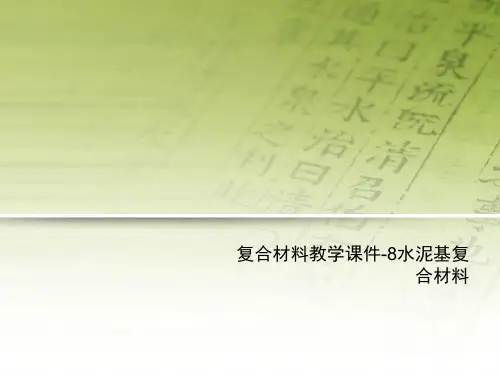
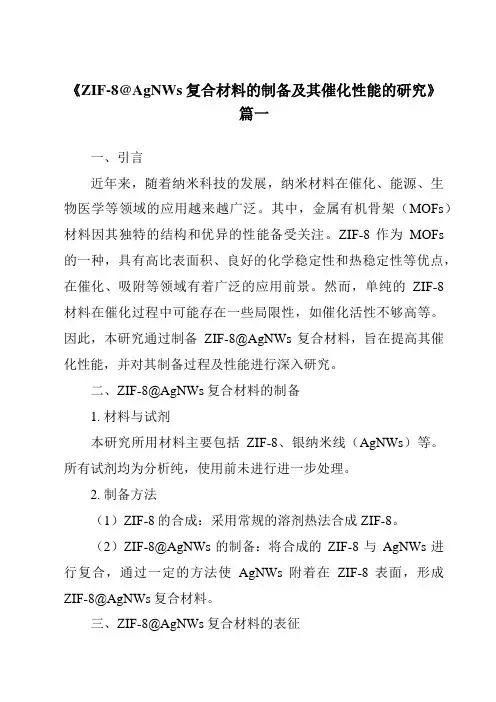
《ZIF-8@AgNWs复合材料的制备及其催化性能的研究》篇一一、引言近年来,随着纳米科技的发展,纳米材料在催化、能源、生物医学等领域的应用越来越广泛。
其中,金属有机骨架(MOFs)材料因其独特的结构和优异的性能备受关注。
ZIF-8作为MOFs 的一种,具有高比表面积、良好的化学稳定性和热稳定性等优点,在催化、吸附等领域有着广泛的应用前景。
然而,单纯的ZIF-8材料在催化过程中可能存在一些局限性,如催化活性不够高等。
因此,本研究通过制备ZIF-8@AgNWs复合材料,旨在提高其催化性能,并对其制备过程及性能进行深入研究。
二、ZIF-8@AgNWs复合材料的制备1. 材料与试剂本研究所用材料主要包括ZIF-8、银纳米线(AgNWs)等。
所有试剂均为分析纯,使用前未进行进一步处理。
2. 制备方法(1)ZIF-8的合成:采用常规的溶剂热法合成ZIF-8。
(2)ZIF-8@AgNWs的制备:将合成的ZIF-8与AgNWs进行复合,通过一定的方法使AgNWs附着在ZIF-8表面,形成ZIF-8@AgNWs复合材料。
三、ZIF-8@AgNWs复合材料的表征1. 形貌分析采用扫描电子显微镜(SEM)和透射电子显微镜(TEM)对ZIF-8@AgNWs复合材料的形貌进行观察。
结果显示,AgNWs成功附着在ZIF-8表面,形成均匀的复合材料。
2. 结构分析通过X射线衍射(XRD)和拉曼光谱对ZIF-8@AgNWs复合材料的结构进行分析。
结果表明,复合材料具有ZIF-8和AgNWs 的特征峰,证明两者成功复合。
四、催化性能研究1. 催化反应的选择本研究选择某类有机反应作为研究对象,探究ZIF-8@AgNWs复合材料的催化性能。
2. 催化性能测试在相同的反应条件下,分别对ZIF-8、AgNWs和ZIF-8@AgNWs进行催化性能测试。
结果显示,ZIF-8@AgNWs复合材料具有较高的催化活性,反应速率明显高于ZIF-8和AgNWs。

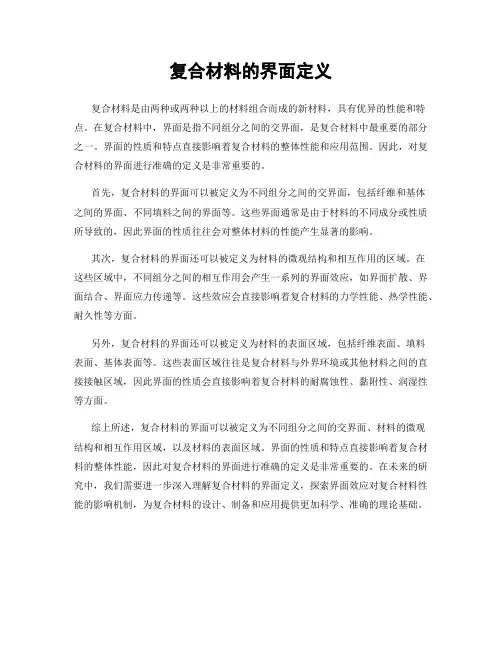
复合材料的界面定义
复合材料是由两种或两种以上的材料组合而成的新材料,具有优异的性能和特点。
在复合材料中,界面是指不同组分之间的交界面,是复合材料中最重要的部分之一。
界面的性质和特点直接影响着复合材料的整体性能和应用范围。
因此,对复合材料的界面进行准确的定义是非常重要的。
首先,复合材料的界面可以被定义为不同组分之间的交界面,包括纤维和基体
之间的界面、不同填料之间的界面等。
这些界面通常是由于材料的不同成分或性质所导致的,因此界面的性质往往会对整体材料的性能产生显著的影响。
其次,复合材料的界面还可以被定义为材料的微观结构和相互作用的区域。
在
这些区域中,不同组分之间的相互作用会产生一系列的界面效应,如界面扩散、界面结合、界面应力传递等。
这些效应会直接影响着复合材料的力学性能、热学性能、耐久性等方面。
另外,复合材料的界面还可以被定义为材料的表面区域,包括纤维表面、填料
表面、基体表面等。
这些表面区域往往是复合材料与外界环境或其他材料之间的直接接触区域,因此界面的性质会直接影响着复合材料的耐腐蚀性、黏附性、润湿性等方面。
综上所述,复合材料的界面可以被定义为不同组分之间的交界面、材料的微观
结构和相互作用区域,以及材料的表面区域。
界面的性质和特点直接影响着复合材料的整体性能,因此对复合材料的界面进行准确的定义是非常重要的。
在未来的研究中,我们需要进一步深入理解复合材料的界面定义,探索界面效应对复合材料性能的影响机制,为复合材料的设计、制备和应用提供更加科学、准确的理论基础。
高中化学复合材料知识点总结复合材料的结构通常是一个相为连续相,称为基体;基体的作用是将增强体粘合成整体并使复合材料具有一定的形状,传递外界作用力、保护增强体免受外界的各种侵蚀破坏作用。
当然也决定复合材料的某些性能和加工工艺。
高中学习网小编为您带来高中化学复合材料知识点,希望对大家有所帮助!高中化学复合材料知识点(一)1、复合材科的定义、组分功能和作用:定义:由两种或两种以上物理和化学性质不同的物质组合而成的一种多相固体材料。
复合后的产物为固体时才称为复合材料,为气体或液体不能称为复合材料。
组分:其组分相对独立,通常有一相连续相,称为基体,另一相分散相,称为增强相(增强体)。
功能和作用:复合材料既可以保持原材料的特点,又能发挥组合后的新特征,可以根据需要进行设计,从而最合理地达到使用所要求的性能。
2、复合材料的命名强调基体,以基体材料的名称为主,如树脂基复合材料,金属基复合材料,陶瓷基复合材料等;强调增强体,以增强体材料的名称为主,如玻璃纤维增强复合材料,碳纤维增强复合材料,陶瓷颗粒增强复合材料;基体材料与增强体材料名称并用,如玻璃纤维增强环氧树脂复合材料(玻璃钢)。
3、复合材料的分类方式按基体材料类型分:聚合物基复合材料,金属基复合材料,无机非金属基复合材料;按增强材料种类分:玻璃纤维复合材料,碳纤维复合材料,有机纤维复合材料,金属纤维复合材料,陶瓷纤维复合材料;按增强材料形态分:连续纤维复合材料,短纤维复合材料,粒状填料复合材料,编制复合材料;按用途分:结构复合材料,功能复合材料;4、常用的基体材料及各自的适用范围轻金属基体(主要包括铝基和镁基),用于450℃左右;钛合金及钛铝金属间化合物作基体的复合材料,适用温度650℃左右,镍、钴基复合材料可在1200℃使用。
5、常用热固性基体复合材料:环氧树脂,热固性聚酰亚胺树脂。
常用热塑性基体复合材料:聚醚醚酮,聚苯硫醚,聚醚砜,热塑性聚酰亚胺。
常用陶瓷基体复合材料:玻璃,氧化物陶瓷,非氧化物陶瓷,无机胶凝材料;6、玻璃和玻璃陶瓷的定义及不同玻璃是无机材料经高温熔融、冷却硬化而得到的一种非晶态固体;玻璃陶瓷是将特定组成的玻璃进行晶化热处理,在玻璃内部均匀析出大量微小晶体并进一步长大,形成致密的微晶相;玻璃相充填于晶界,得到的像陶瓷一样的多晶固体材料。
论文题目:复合材料的界面问题研究学院:材料科学与工程学院专业:材料学任课老师:霍冀川姓名:夏松钦学号:2011000148复合材料的界面问题研究摘要:界面问题,在复合材料制备中起很大的作用,界面结合的好坏,直接影响复合材料的整体性能,现针对国内外增强树脂用玻璃纤维、碳纤维及芳纶纤维的表面处理方法,强调界面问题的重要性关键词:界面问题;玻璃纤维;碳纤维;芳纶纤维1 前言界面是复合材料极为重要的微观结构,它作为增强体与基体连接的“桥梁”,对复合材料的物理机械性能有重要的影响。
随着对复合材料界面结构及优化设计研究的不断深入。
研究材料的界面力学行为与破坏机理是当代材料科学、力学、物理学的前沿课题之一。
复合材料一般是由增强相、基体相和它们的中间相(界面相)组成,各自都有其独特的结构、性能与作用,增强相主要起承载作用;基体相主要起连接增强相和传载作用,界面是增强相和基体相连接的桥梁,同时是应力的传递。
对增强相和基体相的研究已取得了许多成果,而对作为复合材料3大微观结构之一的界面问题的研究却不够深入,其原因是测试界面的精细方法运用起来较困难,其理论尚不完整,尤其从力学的角度研究界面的性质、作用及其对复合材料力学性能的影响和破坏机理等方面的工作正在开展。
界面的性质直接影响着复合材料的各项力学性能,尤其是层间剪切、断裂、抗冲击等性能,因此随着复合材料科学和应用的发展,复合材料界面及其力学行为越来越受到重视。
热塑性复合材料不仅有优越的力学性能、耐腐蚀、无毒性和低价格指数,还由于具有热固性复合材料所不具备的可重复加工和使用的特点,避免产生三废,有利于环保,因而倍受人们的重视,发展很迅速。
对于增强热塑性复合材料来说,由于基体本身缺乏可反应的活性官能团,很难与纤维产生良好化学键结合,因而界面结合的问题就显得更为重要。
2玻璃纤维的表面处理方法玻璃纤维在复合材料中主要起承载作用。
为了充分发挥玻璃纤维的承载作用,减少玻璃纤维和树脂基体差异对复合材料界面的影响,提高与树脂基体的粘合能力,因此有必要对玻璃纤维的表面进行处理[1],使之能够很好地与树脂粘合,形成性能优异的界面层,从而提高复合材料的综合性能。
ResearchEnvironmental Protection—ArticleMoS 2/ZIF-8Hybrid Materials for Environmental Catalysis:Solar-Driven Antibiotic-DegradationEngineeringWen-Qian Chen a ,c ,#,Lin-Yue Li a ,b ,#,Lin Li a ,Wen-Hui Qiu d ,e ,Liang Tang a ,b ,⇑,Ling Xu a ,Ke-Jun Xu a ,Ming-Hong Wu a ,b ,⇑aSchool of Environmental and Chemical Engineering,Shanghai University,Shanghai 200444,Chinab Key Laboratory of Organic Compound Pollution Control Engineering,Ministry of Education,Shanghai 200444,China cShanghai Institute of Applied Radiation,Shanghai University,Shanghai 201800,China dGuangdong Provincial Key Laboratory of Soil and Groundwater Pollution Control,School of Environmental Science and Engineering,Southern University of Science and Technology,Shenzhen 518055,China eState Environmental Protection Key Laboratory of Integrated Surface Water-Groundwater Pollution Control,School of Environmental Science and Engineering,Southern University of Science and Technology,Shenzhen 518055,Chinaa r t i c l e i n f o Article history:Received 11October 2018Revised 4February 2019Accepted 15February 2019Available online 4April 2019Keywords:1T/2H-MoS 2ZIF-8Antibiotic degradation Photocatalysisa b s t r a c tPhotocatalytic water purification is an efficient environmental protection method that can be used to eliminate toxic and harmful substances from industrial effluents.However,the TiO 2-based catalysts cur-rently in use absorb only a small portion of the solar spectrum in the ultraviolet (UV)region,resulting in lower efficiency.In this paper,we demonstrate a molybdenum disulfide/zeolitic imidazolate framework-8(MoS 2/ZIF-8)composite photocatalyst that increases the photocatalytic degradation of ciprofloxacin (CIP)and tetracycline hydrochloride (TC)by factors of 1.21and 1.07,respectively.The transformation products of CIP and TC from the catalysis processes are tentatively identified,with the metal–organic framework (MOF)being considered to be the main active species with holes being considered as the main active species.The hydrogen production rate of the MoS 2/ZIF-8nanocomposites is 1.79times higher than that of MoS 2.This work provides a novel perspective for exploring original and efficient 1T/2H-MoS 2/MOF-based photocatalysts by optimizing the construction of surface nano-heterojunction structures.The composite photocatalyst is found to be durable,with its catalytic performance being preserved under stability testing.Thus,1T/2H-MoS 2/MOF-based photocatalysts have excellent prospects for practical antibiotic-degradation engineering.Ó2019THE AUTHORS.Published by Elsevier LTD on behalf of Chinese Academy of Engineering and Higher Education Press Limited Company.This is an open access article under the CC BY-NC-ND license(/licenses/by-nc-nd/4.0/).1.IntroductionGiven the current global awareness of and attention to environ-mental pollution,the demand for new environmental-restoration technologies is increasing in many areas,including water pollution.One serious water pollution concern involves the abuse of a large number of broad-spectrum antibiotics,including ciprofloxacin (CIP)and tetracycline hydrochloride (TC),which end up in the water supply.Antibiotics pollution in water is known to be a major issue for human health [1–3].Over the past few years,various technologies to reduce antibiotics emission have been employed in environmental protection;these include physical adsorption [4,5],microbial degradation [6],and photocatalytic degradation [7].Among these,semiconductor-based photocatalysis is consid-ered to be an effective solution for antibiotics pollution in water due to its environmental friendliness,low energy consumption,and low cost [8,9].However,in comparison with pollutants such as dyes,it is relatively difficult to photodegrade antibiotics [10,11].Therefore,there is a great need for the development of new effective photocatalysts with higher antibiotic-degradation efficiency.Molybdenum disulfide (MoS 2)is a transition metal dichalco-genide catalyst with a structure that is similar to a two-dimensional (2D)graphene analog layered structure that has been attracting a great deal of attention in the catalysis of antibiotic degradation [12,13].The S A Mo A S coordination in the lattice is similar to a ‘‘sandwich”structure,and produces an unsaturatedhttps:///10.1016/j.eng.2019.02.0032095-8099/Ó2019THE AUTHORS.Published by Elsevier LTD on behalf of Chinese Academy of Engineering and Higher Education Press Limited Company.This is an open access article under the CC BY-NC-ND license (/licenses/by-nc-nd/4.0/).⇑Corresponding authors.E-mail addresses:tang1liang@ (L.Tang),mhwu@ (M.-H.Wu).#These authors contributed equally to this work.Engineering 5(2019)755–767Contents lists available at ScienceDirectEngineeringjo ur na l h o me pa ge :w w w.e ls ev ie r.c o m/lo c a t e/engphenomenon at the edges[14].In addition,MoS2has a tunable band gap structure,which varies from an indirect band gap of 1.2eV(for bulk MoS2)to an indirect band gap of1.8eV(for mono-layer MoS2)[15,16].However,the limitations of its narrow band gap and specific surface area impede the catalytic activity of MoS2.Therefore,MoS2has been constructed into different mor-phologies in order to improve its catalytic performances,including nanosheets,nanoparticles,and quantum dots.MoS2has two com-mon phases[17]:the metallic1T-MoS2,with more catalytically active sites,and the semiconducting2H-MoS2,with more active edge zones.It is necessary to synthesize mixed-phase MoS2with many active edge sites in order to maximize the photocatalytic activity of this catalyst.A metal–organic framework(MOF)is a kind of crystalline mate-rial with high porosity and a huge surface area,which has shown varying degrees of potential in catalysis application[18,19].Zeoli-tic imidazolate framework-8(ZIF-8)is a typical member of the MOF family that consists of zinc(Zn)ions and imidazole linkers. ZIF-8has been widely studied due to its high specific surface area, excellent thermal/chemical stability,and carbon dioxide(CO2) affinity[20,21].Thus,it is assumed that the combination of ZIF-8 nanocrystals with MoS2nanosheets will greatly increase the speci-fic surface area,adsorption,and number of photocatalytic reaction sites,thereby improving the photocatalytic degradation efficiency of the entire photocatalyst.In this work,we demonstrate that ZIF-8being tightly anchored on the1T/2H-MoS2nanosheets.In terms of catalytic performance,the composite catalyst shows greater photocatalytic antibiotic degradation activity than MoS2 on its own.2.Experiments2.1.Preparation of ZIF-8nanocrystalsThe ZIF-8was synthesized according to previously published procedures[22].In general, 1.81g of zinc nitrate hexahydrate (Zn(NO3)2Á6H2O)was dissolved in10mL of deionized(DI)water;1.0g of2-methylimidazole(2-MeIm,AR)was then dissolved in 10mL of ammonia solution(NH3ÁH2O,AR).Next,the2-MeIm solu-tion was slowly added in a drop-wise manner to the zinc nitrate solution,which was magnetically stirred at room temperature for 8h.Thefinal product was subsequently centrifuged and washed to neutrality.Finally,the white ZIF-8nanocrystal was obtained after freeze-drying for12h.2.2.Preparation of1T/2H-MoS2/ZIF-8composite1T/2H-MoS2/ZIF-8was prepared by a solvothermal method.In brief,0.151g(2mmol)thioacetamide(TAA,AR!99.0%),0.242g (1mmol)sodium molybdate(Na2MoO4,AR!99.0%),and0.05g (0.14mmol)cetyltrimethyl ammonium bromide(CTAB,AR)were dissolved in10mL DI water,which was stirred for5min to obtaina homogeneous solution.An amount of ZIF-8(a mass of8.0,11.2,16.0,24.0,or32.0mg)was then added to the mixed solution.Sub-sequently,40mL of N,N-dimethylformamide(DMF,AR!99.5%) was added to the mixed solution.After sonicating for2h,the mixed solution was transferred into a Teflon autoclave and kept in an oven at200°C for24h.Thefinal black product was cen-trifuged at8000rÁminÀ1and washed with75vol%ethanol.Finally, the prepared black product was freeze-dried for24h.The samples were marked as MZ-5,MZ-7,MZ-10,MZ-15,and MZ-20,where MZ refers to the MoS2/ZIF-8composite and the numbers refer to the weight content of ZIF-8(i.e.,5%,7%,10%,15%,and20%,respec-tively).The schematic synthesis procedure is shown in Fig.1.Pure MoS2was synthesized by a similar solvothermal method without the addition of ZIF-8.2.3.Characterization of1T/2H-MoS2/ZIF-8The phase structure of these samples was determined using D8 ADVANCED powder X-ray diffraction(XRD,Bruker Corporation, Germany).The microstructures and components of the as-prepared products were determined using a JEM-2010F transmis-sion electron microscope(TEM,JEOL Ltd.,Japan)and a FESEM-4800scanning electronic microscope(SEM,Hitachi Ltd.,Japan). The ultraviolet–visible light diffuse reflectance spectra(UV–vis DRS)were obtained using an Cary300spectrometer(Agilent Tech-nologies,USA).The excitation wavelength of the photolumines-cence(PL)spectrum was365nm(F-7000fluorescence spectrophotometer,Hitachi Ltd.,Japan).2.4.Photocatalytic activity measurementsThe photocatalytic degradation of aqueous solutions of CIP (purity!98.0%,20mgÁLÀ1)and TC(purity!98.0%,20mgÁLÀ1) was performed on1T/2H-MoS2/ZIF-8composites under visible light irradiation.A300W xenon(Xe)lamp(Nanjing Sidongke Elec-trical Equipment Co.,China)with a420nm cut-offfilter was used as a natural light source.In each test,a20mg sample of catalyst and50mL of the target pollutant(dissolved in water)were mixed in a quartz tube.Before irradiation,the solution was stirred for 30min under dark conditions.During irradiation,2mL of the mixed solution was taken out of the reactor andfiltered with a 0.45l m needlefilter.The absorbance peaks for CIP(276nm)and TC(357nm)were measured using a TU-1810spectrophotometer (PERSEE Ltd.,China)[23,24].The photocatalytic hydrogen(H2)evo-lution reactions were performed in an airtight quartz reactor with cooling water in order to maintain the reaction temperature at 25°C;a500W Xe lamp was used as a natural light source.Prior to irradiation,25mg of photocatalyst powder was dispersed in 50mL of15vol%triethanolamine(TEOA,AR)aqueous solution. During irradiation,H2was detected by a gas chromatograph (GC7920,Beijing CEAULIGHT Co.Ltd.,China)with nitrogen(N2) as the carrier gas.The area of the integrated peak of the gas chro-matography(GC)curve was compared with the area of the integral peak of the standard H2curve at a certain volume;the actual amount of H2was then calculated.The degradation intermediates were detected by means of high-performance liquid chromatogra-phy–tandem mass spectrometry(LC–MS/MS,6460Triple Quad LC–MS/MS,Agilent).Detailed analysis methods for the degradation products are provided in Appendix A.2.5.Photoelectrochemical performanceTransient photocurrent electrochemical impedance spec-troscopy(EIS)and Mott–Schottky plots were conducted on an elec-trochemical analyzer(CHI660E electrochemical workstation, Chenhua Instrument,Shanghai,China).The as-synthesized sam-ples were used as the working electrode,while a saturated calomel electrode(SCE)and a platinum sheet were used as the reference electrode and counter electrode,respectively.Detailed methods for the preparation of photoelectrodes are reported in the litera-ture[25].A500W Xe arc lamp with a420nm cut-offfilter was used as a light source.The Mott–Schottky tests were implemented using the impedance-potential mode.EIS tests were performed at an open-circuit potential in a frequency range between105and 10À2Hz in a dark environment.In all experiments,0.5molÁLÀ1 Na2SO4aqueous solution was used as the electrolyte.756W.-Q.Chen et al./Engineering5(2019)755–7673.Results and discussion3.1.Microstructures and componentsThe crystallinity of MoS 2and of the 1T/2H-MoS 2/ZIF-8nanocomposites was investigated by XRD;measurement results are displayed in Fig.2.The XRD pattern of the synthesized MoS 2was different from that of pristine 2H-MoS 2,as new (002)and sec-ond (002)*diffraction peaks of the as-synthesized MoS 2showed at 9.6°and 18.0°,respectively [26].According to the Bragg equation,the lattice spacing of the (002)plane was calculated to be 0.95nm (Fig.3(e)),which aligned with the interlayer distance from the TEM images.The increase in the interlayer distance of the MoS 2indirectly indicated that the prepared MoS 2was a metallic 1T phase [27].Fig.3(f)shows that a fringe spacing of 0.27nm can indicate the (100)crystal plane index of 2H-MoS 2.As indicated by Fig.S1(a),it is evident that in comparison with the standard value (JCPDS Card No.37-1492),the two diffraction peaks at 32.7°and 58.4°respectively indicate the (100)and (110)planes.The results indicate that the local atomic arrangement remains the same as that of the standard 2H-MoS 2structure [28],which confirms that the prepared MoS 2is a polytype phase.In addition,it can be seen from Fig.S1(b)that the MZ-20nanocomposite con-tains ZIF-8crystal,which signifies that the ZIF-8is in close contact with the MoS 2nanosheets.Fourier transform infrared (FT-IR)spec-troscopy of the MZ-7and ZIF-8are shown in Fig.4.The presence of ZIF-8is revealed by the following characteristic peaks:the band at 421cm À1is attributed to the Zn A N stretch,and other bands in the spectral region of 500–1500cm À1are due to plane bending and stretching of the imidazole ring [29].It is worth noting that the same adsorption bands were observed for the MZ-7nanomaterial.For MZ nanomaterials,it can be seen that the characteristic peaks are consistent with those of pure MoS 2(Fig.S2),which confirms that the metal-phase MoS 2was successfully prepared.We examined pure MoS 2,MZ-7,and MZ-20samples by SEM (Fig.S3)and TEM (Fig.3)to understand the degree of complexation of the ZIF-8crystals with MoS 2.As shown in Figs.S3(a,b),MZ-7exhibits a flower-like structure.Furthermore,these lamella flowers are not completely isolated from each other,but are often superim-posed together.Small particles of ZIF-8fit tightly on the flower-like 1T/2H-MoS 2surface.Careful observation of the morphology of MZ-7shows that many curled and staggered nanosheets grow densely on the surface.In MZ-20,the flower-like structure gradually disap-pears,showing a smooth surface covered by ZIF-8.The probable reason for this structural change is that the increasing content of ZIF-8affects the anisotropic growth and flower-like structureformation of the 1T/2H-MoS 2.As indicated in Figs.3(a–d),which shows TEM images of a single MZ-7petal nanosheet,the 1T/2H-MoS 2nanosheets are curled to form tubular structures.ZIF-8par-ticles are partially attached to the tubular 1T/2H-MoS 2structures.Under electron beam irradiation,these nanosheets are extremely transparent,which indicates that the sheets are very thin (Figs.3(b,c)).An ultrathin tubular structure is more conducive to the rapid transmission of photo-induced electrons,and thus reduces the recombination rate.Fig.5shows the presence of the elements sulfur (S),molybdenum (Mo),Zn,nitrogen (N),and carbon (C)in the MZ-7nanocomposite.It is notable that these elements are uniformly distributed throughout the MZ-7,and it is further confirmed that the ZIF-8is very uniformly dispersed and attached to the 1T/2H-MoS 2.The pore characteristics of the as-prepared samples were investigated by the N 2physical sorption method (Fig.6).The N 2adsorption/desorption isotherms of MZ-5,MZ-7,MZ-10,MZ-15,and MZ-20are type IV adsorption curves (Figs.6and S4(a–c)).At higher relative pressures (P =P 0),the MZ-7sample exhibits higher adsorption performance compared with other prepared samples,which reveals the existence of cumulative pores [30].Unlike the MZ nanocomposites,a distinctive type I isotherm is shown by the ZIF-8(Fig.S4(d)).The specific surface areas of MZ-5,MZ-7,MZ-10,MZ-15,and MZ-20were measured to be 17.789,33.308,25.150,11.482,and 27.354m 2Ág À1,respectively (Table S1).These findings show that MZ-7provides more adsorptionandFig.1.A schematic illustration of the preparation of MZnanocomposites.Fig.2.XRD patterns of MoS 2and MZ.W.-Q.Chen et al./Engineering 5(2019)755–767757photocatalytic active sites than the other nanocomposites.In addition,as shown in the inset of Fig.6(a),MZ-7mainly contains mesoporous types (2–8nm)corresponding to the Barrett–Joyner–Halenda pore-size distribution curve.Furthermore,the pore-size distribution curve of MZ-20shows that the main pore-size range is 1–6nm (inset Fig.6(b)).This may be because the addition of ZIF-8affects the particle size of 1T/2H-MoS 2.The synergistic effect of its various pores and the high specific surface area of MZ-7are conducive to the rapid mass transfer of the target contaminant molecules and diffusion of photo-induced electrons [31];thus,MZ-7is expected to display excellent photocatalytic degradation.The elemental composition and functional characterization of the 1T/2H-MoS 2/ZIF-8nanomaterials were further confirmed by X-ray photoelectron spectroscopy (XPS).In Fig.7(a),the XPS survey spectrum shows that MZ-7mainly consists of the elements S,Mo,Zn,C,and N.The XPS results of S 2p are displayed in Fig.7(b).The MZ-7has three peaks at 163.8,162.4,and 160.9eV that can be assigned to S 2p 1/2and S 2p 3/2[32].As shown in Fig.7(c),the Mo 3d binding energy spectrum of MZ-7has four peaks at 235.0,231.7,228.1,and 225.3eV,which corroborate the presence of Mo 3d 5/2and 3d 3/2[23].When the S 2p and Mo 3d spectra of MZ-7and MoS 2are compared,the result indicates that the S 2p and Mo 3d spectra of MZ-7shift to higher binding energies by 0.7eV,which satisfies the previously observed relaxation energy before the formation of 1T-MoS 2.A significant increase in bindingenergyFig.3.(a–d)TEM images and (e,f)high-magnification TEM images of the MZ-7nanocomposites.Fig.4.FT-IR spectra of MZ-7and ZIF-8.758W.-Q.Chen et al./Engineering 5(2019)755–767of 0.70eV usually indicates a loss of electron density [33],which can generate more active vacancies and thus increase the photo-catalytic effect.As illustrated in Figs.7(d–f),the results suggest that the composite MZ-7,which includes ZIF-8,contains the elements Zn,C,and N.Two peaks are observed at 1044.0eV (Zn 2p1/2)and 1020.9eV (Zn 2p3/2),respectively,which correspond to the Zn 2+of the ZIF-8(Fig.7(d)).As a comparison,the Zn 2p peaks of ZIF-8are located at 1044.7eV and 1021.6eV.MZ-7shows a neg-ative shift of 0.7eV relative to ZIF-8,which may be due to electron transfer [34].In the C 1s XPS spectrum (Fig.7(e)),three binding energies of MZ-7peak at 288.5,285.9,and 284.5eV;these can be assigned to the carboxyl carbon (O @C A O),hydroxyl carbon (C A O),and sp 2-hybridized carbon (C A C)[35].In Fig.7(f),the N 1s band peaks are 398.8,397.0,and 394.5eV;these can be attrib-uted to the C A N bond and the 2-methylimidazole nitrogen atoms [36].The XPS results reveal that MoS 2fits snugly on the ZIF-8sur-face,and that specific elements are prominently present in the composite.It is evident that the positions of the S 2p,Mo 3d,and Zn 2p peaks in MoS 2/ZIF-8are shifted a little,indicating that the MoS 2and ZIF-8are interacting with each other.It is likely that the ZIF-8nanocrystals become embedded in the MoS 2nanosheets during the solvent heat treatment [37].Thus,the above analyses indicate that 1T/2H-MoS 2was successfully synthesized in this work.More importantly,the results suggest that the prepared samples have more active sites and more significant photocatalytic effects than MoS 2or ZIF-8on their own.The absorbance performance of the MZ nanocomposites and MoS 2was measured using UV–vis DRS.Fig.8(a)shows that all samples display significantly enhanced light absorption between 200and 800nm.The characteristic absorption for pure ZIF-8isFig.5.Energy-dispersive spectroscopy (EDS)elemental mappings of the obtained MZ-7nanocomposites.Fig.6.N 2sorption isotherms and pore-size distribution of the (a)MZ-7and (b)MZ-20composites.STP:standard temperature and pressure.W.-Q.Chen et al./Engineering 5(2019)755–767759detected at around 225nm (Fig.S5(a)).However,when ZIF-8is loaded with 1T/2H-MoS 2,the light absorption capacity is significantly improved,indicating the importance of the hybrid composite in enhancing photocatalysis.This finding means that the higher visible light absorption of the heterojunction between ZIF-8and 1T/2H-MoS 2leads to the photogeneration of electron-hole pairs,which further promote the photocatalytic performance.The relationship between the wavelength of different nanocom-posites and the photon energy (eV)can be calculated by the Kubelka–Munk function (K–M function),provided below [38]:F R ðÞ¼1ÀR ðÞ22Rð1Þwhere R is the reflectance and F R ðÞis proportional to the absorption coefficient (a ).The relationship between the K–M function and the wavelength of all the synthesized composites is shown in Fig.8(b).As shown inFigs.8(c,d),the band gap energies (E g )of 1T/2H-MoS 2and ZIF-8areestimated from the tangent to the curve of a h m ðÞ1=2(or a h m ðÞ2)with respect to the photo-energy.The band gaps of 1T/2H-MoS 2,ZIF-8,and MZ-7(Fig.S5(b))are 1.13,5.12,and 1.05eV,respectively,indi-cating that the introduction of 1T/2H-MoS 2reduced the band gaps.All the results suggest that the visible light response of the sample is increased;it can now generate more photogenerated carriers to improve the photocatalytic performance.3.2.Photocatalytic propertiesTo assess the potential use of the MZ samples in environmental remediation,their photocatalytic activities were evaluated in terms of the photocatalytic degradation of CIP and TC.As can be observed from Fig.9(a),all samples exhibit catalytic properties in the degradation of CIP.Among the samples,MZ-7has the highest catalytic efficiency,which is in agreement with theBrunauer–Fig.7.XPS spectra of MZ-7compared with pure MoS 2and ZIF-8.(a)Survey scan;(b)S 2p;(c)Mo 3d;(d)Zn 2p;(e)C 1s;(f)N 1s.760W.-Q.Chen et al./Engineering 5(2019)755–767Emmett–Teller (BET)surface area analysis.As the content of ZIF-8increases,the catalytic performance of the samples improves at first,and then gradually decreases.After irradiation for 180min under visible light,the photodegradation rates of CIP by the MZ-7hybrids increased to 93.2%,which is 1.21times greater than that of pure MoS 2.Fig.9(b)depicts the photodegradation kinetics for CIP by the MZ nanocomposites with different amounts of ZIF-8,and by pure MoS 2.The kinetic curve of CIP degradation is in accor-dance with the pseudo first-order linear transformation ln C =C 0ðÞ¼Àkt [39].Meanwhile,the pseudo first-order reaction kinetics (k )value of MZ-7(0.0099min À1)is 1.29times and 1.71times higher than those of MZ-20and pure MoS 2,respectively;this can be attributed to the coupling of the nanostructured sheets and ZIF-8within the ultrathin structure of 1T/2H-MoS 2,which provides a pathway for the rapid transfer of photogenerated charge carriers.The small amount of CTAB helps 1T/2H-MoS 2to generate ultrathin nanosheets [40].It is worth noting that the removal efficiency of TC reaches 75.6%in the presence of the photocatalyst MZ-7at 180min under visible light irradiation (Fig.9(c)).As seen in Fig.9(d),k for the removal of TC on MZ-7is 0.0049min À1(1.53times greater than that of MZ-15).This can be ascribed to the rapid separation role of the photogenerated charge carriers by the 1T-MoS 2.Another important factor is that the porous ZIF-8provides more reactive sites and enhances the progress of photocatalytic degradation.Interestingly,the photocatalytic activity can be improved by dop-ing ZIF-8on the surface of 1T/2H-MoS 2.1T-MoS 2has excellent electrical conductivity and accelerates the transmission of photo-excited electrons,while 2H-MoS 2provides many active attach-ment sites on the edge.In addition,ZIF-8increases the specific sur-face area of MZ-7,giving it more catalytic centers.Moreover,the synergistic effect between 1T/2H-MoS 2and ZIF-8plays an impor-tant role in the degradation of CIP and TC.The photocatalytic activities were assessed by photocatalytic hydrogen evolution reaction in TEOA aqueous solution under visible light irradiation (k !420nm).As shown in Fig.S6,the content of ZIF-8significantly affected the efficiency of hydro-gen production.This test indicated that MZ-7has the greatest photocatalytic activity,with a hydrogen production rate of 61.45l mol Áh À1Ág À1,which is 1.79times greater than that of pure MoS 2.Thus,the test indicated that the addition of an appropriate amount of ZIF-8improved the catalytic activity of 1T/2H-MoS 2for hydrogen production,by increasing the con-ductivity of the material and providing a larger surface of the exposed edges.These findings also explain the improved pho-tocatalytic activity,which is due to the presence of mixed states and induced structural distortions at the boundaries of the MZ-7[41].A more rigorous analysis of these results revealed that a good interfacial heterojunction between 1T/2H-MoS 2and ZIF-8contributes to an efficient charge trans-fer and e ––h +separation.3.3.Repeatability and stability of the MZ compositesIn order to evaluate the application possibilities of this catalyst in the environment,the reusability and stability of MZ-7were also tested.The target pollutant of the cyclic test was replaced with CIP with a solution concentration of 20mg ÁL À1,and the mass of the photocatalyst was 20mg.As seen in Fig.10(a),after two cycles of CIP degradation,the removal rate of CIP was still 90%at the 3rd run within 180min.The photocatalytic activity of MZ-7did not decrease significantly,which indicates that the MZ-7photocatalyst has high stability and can be used repeatedly in practical applications.The XRD result showed that the MZ-7was chemically stable before and after the reaction (Fig.10(b)).Fig.8.(a)UV–vis DRS spectra of MZ nanocomposites and pure MoS 2;(b)plot of K–M function estimated from UV–vis DRS spectra of MZ nanocomposites;(c)plot of a h m ðÞ1=2vs.photo-energy (h m )of pure MoS 2;(d)plot of a h m ðÞ2vs.photo-energy (h m )of ZIF-8.W.-Q.Chen et al./Engineering 5(2019)755–7677613.4.Discussion of the photocatalytic mechanismAlthough we obtained a captivating antibiotic-degradation per-formance with the MZ-7composite,in order to further clarify the photocatalysis mechanism,radical scavenging experiments were conducted.Three typical scavengers (dosage:1mmol ÁL À1)—iso-propyl alcohol,EDTA-2Na,and q -benzoquinone—were employed as the scavengers of _OH,h +,and _O À2,respectively [42].For these experiments,the aqueous solution of CIP was 20mg ÁL À1and the sample quantity was 20mg.As shown in Fig.11(a),the photocat-alytic degradation of CIP was significantly inhibited after the addi-tion of EDTA-2Na,implying that h +plays an active role inphotocatalytic reactions.Furthermore,the photodegradation of CIP was inhibited in the presence of isopropanol,confirming that _OH plays a minor role in photocatalysis.However,the degradation of CIP after the addition of p -benzoquinone was comparable to the absence of sacrificial agent.The PL spectra shown in Fig.11(b)provides information on the separation efficiency of the photo-induced electron–hole (e ––h +)pairs [43].It is shown that the combination of ZIF-8and 1T/2H-MoS 2can severely reduce PL intensity,which confirms that the recombination of e ––h +pairs transferred to the surface of the ZIF-8is hindered.This result is understandable because the flower-like 1T/2H-MoS 2is more conductive to the rapidtransferFig.9.Photodegradation efficiency and photodegradation rate constants for (a,b)CIP and (c,d)TC by MZ nanomaterials and pure MoS 2.C =C 0:normalizedconcentration.Fig.10.(a)Recycled performance chart for the MZ-7composite for CIP;(b)XRD images of the MZ-7composite before and after the photocatalytic reaction.762W.-Q.Chen et al./Engineering 5(2019)755–767。